Sabre 386
Elegant and well-built cruiser for sailors with refined tastes
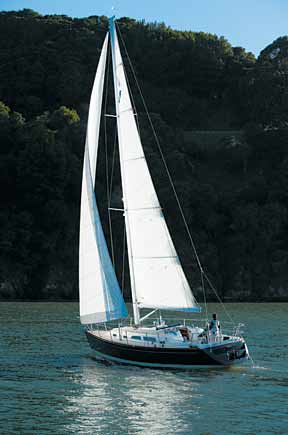 Some modern production builders turn out boats that are almost indistinguishable from those built 30 years ago. Their designs are tried and true. For present purposes we'll call this approach "conservative." Other builders scrap tradition and push the envelope of modern materials and techniques, producing boats that bear only a slight resemblance to their predecessors. We'll call this approach "liberal." The Sabre 386 then represents what we could call a "moderate" approach.
Some modern production builders turn out boats that are almost indistinguishable from those built 30 years ago. Their designs are tried and true. For present purposes we'll call this approach "conservative." Other builders scrap tradition and push the envelope of modern materials and techniques, producing boats that bear only a slight resemblance to their predecessors. We'll call this approach "liberal." The Sabre 386 then represents what we could call a "moderate" approach.
Think of "moderate" before the polarizing elements of American politics got ahold of the word. Think of moderate as intelligent and reasoned, rejecting both dogma and fundamentalism on the one hand, and flights of fancy on the other.
The moderate Sabre 386, introduced in 2004, is immediately recognizable as a "sailing yacht" in shape, layout and build, yet its designers (the Sabre Design Team and Jim Taylor Yacht Design) have tried to overcome some of the less pleasant aspects of earlier designs in the niche. Bentley Collins, marketing manager at Sabre describes the 386 buyer as having a refined taste.
"Typically they are mature sailors. They have been boat owners for 15 years or more," he said. "They are people who have grown up with certain aesthetic standards."
Collins goes on to describe a buyer who appreciates a boat that sails well to weather and is well built, but a sailor who has spent his share of time in confining pilot and quarter berths, and is ready to sleep comfortably. The reality, he says, is that most people are not spending all their sailing days crossing oceans and the boat doesn't need to be laid out as if they were. Hence the "Bentley Collins Big Bed Theory."
"Big beds sell boats," said Collins. The theory holds that so many cruisers spend their nights at anchor rather than under sail that the bunks should be designed accordingly. They should be roomy and easy to get in and out of.
The 386 modernizes the traditional interior layout with large bunks fore and aft, but Collins says the objective was to find some balance between "accommodation" and "storage." The trend of modern designs is to focus more narrowly on creature comforts, sometimes at the expense of practical concerns like locker space. The typical 386 owner will not try to stow six months worth of canned goods aboard the boat, but they should be able to stow the essentials for an offshore passage.
Down below
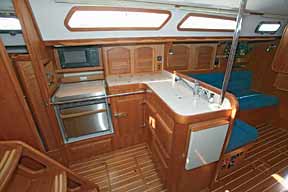 Overall the volume on this 38-footer is moderate, certainly larger than older, narrower-hulled designs, yet there are no ballroom-size spaces as there are in some modern boats. The beam is carried far enough aft that there is space for an athwartship double bunk in the aft cabin and a reasonably spacious sail locker outboard to starboard beyond the bulkhead at the foot of the bunk. The forward cabin eschews a V-berth in favor of a double island berth. There is a sink in the forward cabin, but not a full head (The head is located aft). Hanging lockers are lined with cedar.
Overall the volume on this 38-footer is moderate, certainly larger than older, narrower-hulled designs, yet there are no ballroom-size spaces as there are in some modern boats. The beam is carried far enough aft that there is space for an athwartship double bunk in the aft cabin and a reasonably spacious sail locker outboard to starboard beyond the bulkhead at the foot of the bunk. The forward cabin eschews a V-berth in favor of a double island berth. There is a sink in the forward cabin, but not a full head (The head is located aft). Hanging lockers are lined with cedar.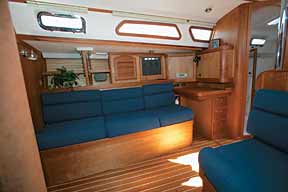 Unlike a number of modern designs, the 386's saloon settees can in fact be used for sleeping. On the port side this is facilitated by a hinged dining table that easily folds up out of the way, and clips to the bulkhead next to the hide-wrapped mast. On the starboard side the navigator uses the aft end of the settee as a seat, and on offshore passages, will be nudging a sleeping shipmate out of the way when he sits down at the aft-facing table. Also, the backrest for the navigator is a settee seatback cushion that does double duty and swings out ninety degrees from its normal position. The navigation table itself is adequately sized, and there is plenty of space to mount electronics.
Unlike a number of modern designs, the 386's saloon settees can in fact be used for sleeping. On the port side this is facilitated by a hinged dining table that easily folds up out of the way, and clips to the bulkhead next to the hide-wrapped mast. On the starboard side the navigator uses the aft end of the settee as a seat, and on offshore passages, will be nudging a sleeping shipmate out of the way when he sits down at the aft-facing table. Also, the backrest for the navigator is a settee seatback cushion that does double duty and swings out ninety degrees from its normal position. The navigation table itself is adequately sized, and there is plenty of space to mount electronics. 
Just aft of the nav station and outboard of the companionway ladder is the head, with sink, toilet and stall shower. The engine is easily accessible behind the hinged companionway ladder and also from the aft cabin. On the port side of the companionway is the L-shaped galley, with gimbaled three-burner stove, microwave, double sink with additional fold-out counter space and a fridge that is accessible both from the top and side. The cherry-veneered furniture is all glassed into the hull for strength, rather than assembled modularly, and the finish quality is good. Take a look at the inside of the cabinets or under the floorboards and you are reassured that Sabre's attention to detail is not just skin deep.
On deck
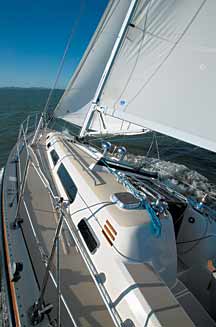 Above deck the lines are clean, and, again, moderate. The freeboard and deckhouse height are in proportion with the length of the boat, and the bow is not too blunt, while the transom incorporates a small swim platform without looking like a spaceship. The stainless dorade vents, grabrails and winch drums add some bling to the deck in a handsome way.
Above deck the lines are clean, and, again, moderate. The freeboard and deckhouse height are in proportion with the length of the boat, and the bow is not too blunt, while the transom incorporates a small swim platform without looking like a spaceship. The stainless dorade vents, grabrails and winch drums add some bling to the deck in a handsome way.
The cockpit is comfortable. There is enough space to get around the 40-inch wheel, but it's still easy to brace yourself in choppy seas. Engine controls are mounted on the starboard side of the compass binnacle, and just forward of the binnacle is a stainless horseshoe-shaped bar for mounting electronics, which serves a purpose but detracts from what is otherwise a very smart looking cockpit and deck. The lazarette is accessed through the port and starboard dish-shaped helmsman's seats and is roomy enough to accommodate a collection of oversize fenders.
The sail locker is under the starboard cockpit bench and its size reflects the smaller inventory of canvas a modern cruiser travels with. Under the port side cockpit bench is a hatch meant to let some light and air into the aft cabin while at anchor. The primary winches are just forward of the wheel, accessible to either the helmsman or cockpit crew, while the halyards and mainsheet run to cabintop winches mounted on either side of the companionway.
The now practically ubiquitous midboom sheeting runs to a traveler forward of the companionway hatch. Dual tracks have been mounted for taming the headsail, one inside the shrouds and the other outside the lifelines on the wood toerail. The mast is keel-stepped and stands 56 feet, 4 inches above the waterline. It is a twin-spreadered masthead rig with a split backstay that is hydraulically tunable on the port side. Forward on deck is a very large chain locker, which takes the place of foc's'le storage in the forward cabin, and the option of a power windlass.
The details
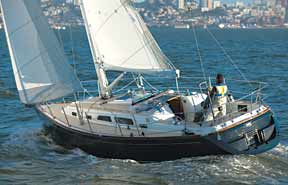 Both hull and deck are divinycell cored E-glass, with reinforced hardware mounts. The glassed-in furniture, much less common these days, adds structural rigidity to the hull. Under sail and underfoot the 386 feels sturdy but not heavy. The 40-horsepower Yanmar drives the 18,000-pound boat without difficulty. H+S Yacht Sales had just brought the boat we tested (hull No. 4) out to San Francisco Bay and had not yet installed instruments, so there were no specifics on speed. The full-batten mainsail was easy to hoist with the electric halyard winch, and easy for the crew to trim with all the relevant lines run to the cabintop.
Both hull and deck are divinycell cored E-glass, with reinforced hardware mounts. The glassed-in furniture, much less common these days, adds structural rigidity to the hull. Under sail and underfoot the 386 feels sturdy but not heavy. The 40-horsepower Yanmar drives the 18,000-pound boat without difficulty. H+S Yacht Sales had just brought the boat we tested (hull No. 4) out to San Francisco Bay and had not yet installed instruments, so there were no specifics on speed. The full-batten mainsail was easy to hoist with the electric halyard winch, and easy for the crew to trim with all the relevant lines run to the cabintop.
The helm has a layer of foam padding under the hide grip, which is at first disconcerting to sailors accustomed to the rigidity of stainless or carbon beneath the covering, but after a few minutes the comfort advantage becomes obvious. The steering is responsive and light without tending toward twitchiness. The rudder stock is made of carbon fiber.
Under sail
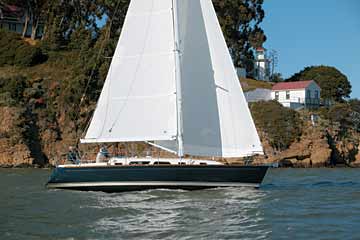 We saw 15 knots of wind from the west with gusts to 20 during the test sail and the deep-keel version of the 386, which draws 6 feet, 10 inches proved stiff and accelerated well in the puffs. She was easy to handle and felt sporty for a luxury cruising boat, seeming lighter than her actual weight. Sabre estimates a PHRF rating of 81, and it's not unreasonable to expect that a certain number of owners will be inspired to enter club races that they might avoid in another boat. By way of comparison, the 386's handicap is 21 seconds per mile faster than the Sabre 38 MK II, which it replaces and was introduced in 1985.
We saw 15 knots of wind from the west with gusts to 20 during the test sail and the deep-keel version of the 386, which draws 6 feet, 10 inches proved stiff and accelerated well in the puffs. She was easy to handle and felt sporty for a luxury cruising boat, seeming lighter than her actual weight. Sabre estimates a PHRF rating of 81, and it's not unreasonable to expect that a certain number of owners will be inspired to enter club races that they might avoid in another boat. By way of comparison, the 386's handicap is 21 seconds per mile faster than the Sabre 38 MK II, which it replaces and was introduced in 1985. 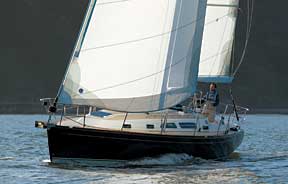 The 386 is set up to be handled by a couple, and is in fact easy to sail with two people. It would be comfortable enough to cruise with two couples, but the boat doesn't steer the imagination toward thoughts of cocktail parties and barbecues. It's primary inspiration is sailing yacht rather than screened porch.
The 386 is set up to be handled by a couple, and is in fact easy to sail with two people. It would be comfortable enough to cruise with two couples, but the boat doesn't steer the imagination toward thoughts of cocktail parties and barbecues. It's primary inspiration is sailing yacht rather than screened porch.
Overall the 386 seems to be just what Sabre says it is, a well-built, well-outfitted performance cruiser with a sail-away price around $290,000. There isn't anything foolish or ill considered about it. It's a moderate in the best sense of the word and, for that, it should appeal to the experienced sailors Sabre hopes to attract.

Comments